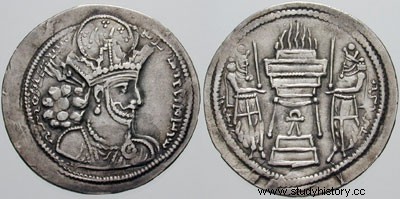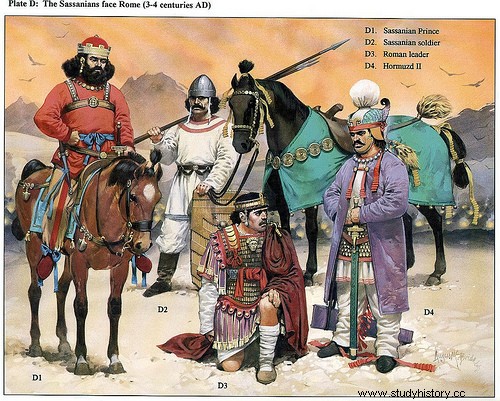Our archenemy today is one of the Asian despots deliberately ignored by the classical sources. His father was the one who created a new Empire that, under his iron hand, managed to displace the Parthians and shake Rome itself. During his mandate there were three turning points that would mark the future of the Roman Empire.
Seventeenth installment of “Archienemies of Rome “. Collaboration of Gabriel Castelló.
Sapor He was born in 215 AD and was the firstborn of King Ardhasir I , conceived, according to some legends, by an Arsacid princess. Practically since Marcus Licinius Crassus' disaster at Carrhae (Harran plain, Turkey) in 53 B.C. facing the Parthians, the eastern frontier had remained stable. It was Ardhasir who erased from history the horsemen who humiliated the Republic for years, replacing their irregular control of the territory with a despotic form of government similar to the Achaemenid tradition. Therefore, their desire for expansion and national consolidation had a clear obstacle:Rome.

Sapor
Ardhasir's campaigns against Rome were confused and little addressed by the historians of the time, obtaining some irrelevant victories and defeats at the political and border levels. It was during this war that Sapor replaced his father as head of the Persian crown. Timesitheus, former tutor, prefect and father-in-law of Emperor Gordian III, dismantled the expansionist desires of the young king in 243, being forced to abandon the territories of Mesopotamia that he had occupied.
As expected in such convulsive times, the Roman fortress vanished like the dunes of the desert as this or that tribe pressed on the limes of Europe. Timesiteus died in strange circumstances, as did his young son-in-law, an ambitious Praetorian known as Philip the Arab taking the purple, who, in turn, also died after the battle he sustained with Decius, legate of the Danube legions and exalted by his men to the imperial purple. The Goths crossed the Danube in 251 and in the confrontation between the legions and the barbarians in the Abrito swamp (Razgrad, Bulgaria) Emperor Decius died. It was the first time that a Roman regent had fallen in combat against barbarian tribes. First turning point.
All this internal and external weakness gave Sapor wings to resume the expansionist plan that his father had to abort. For this reason, being at that time already emperor Valeriano , he began a new campaign that ravaged the province of Syria, even sacking Antioch , populous and prosperous city, one of the three great capitals of the Empire along with Rome and Alexandria. It was the first time that a large walled city had been assaulted by a foreign army. Second turning point.
Armenia fell under his control and King Tiridates II had to take refuge in Asia Minor. Despite having the Danubian limes in tatters, Valerian went to the East worried about the virulence of the new Persian king (bear in mind that Goths or Sarmatians were "barbarians" in the second division compared to the Persians, cruel and refined according to the biased Greek vision )

Persian Society
Valerian recovered Antioch in 257, but a new Gothic incursion into Asia Minor caused him to suspend the Persian campaign, which he resumed in 259 marching against Sapor, who, at the time, was besieging the Syrian city of Edessa (southeastern Anatolia, Turkey). In one of the most ignominious actions of the time, the emperor fell into a trap, perhaps set by his prefect Macrinus, and was taken prisoner by the Persians. There are conflicting sources about his final fate. Some historians recounted his death in Edessa, while others argued that Valerian was taken to Persia as a hostage by Shapur and a year after his capture, he was made to drink molten gold and his skin was displayed as a trophy in the great temple of Gundev. -Sapur, a new city near the ancient Susa. Persian sources defend this second version. Valerian was the first emperor to fall prisoner to a barbarian nation. Third turning point.
When everything seemed lost for Rome, an ally appeared that we already talked about at the time, Odenato de Palmira (the husband of the future queen Zenobia), regaining lost territory in Syria and Asia Minor and even capturing the seraglio from Shapur himself. Odaenathus' intervention marked the end of his expansion into the Roman East. Contenting the Persian king with holding the border in the desert of Mesopotamia, he devoted the rest of his reign to fortifying the East, consolidating a state that would endure for four hundred years, the Sassanid Persian Empire .
Perhaps one of the most appreciated courtiers by the Persian king was Mani , a syncretistic visionary whose doctrine, Manicheism , penetrated deep among the population of Egypt, Syria, Palestine and Asia Minor. The king himself and his eldest son were his followers, thus confronting the caste of magicians faithful to the reformer Zoroaster and faithful to the god Ahura Mazda. Sapur felt heir to the Achaemenid tradition, he had himself sculpted in stone along with the great Persian kings on horseback showing Valerian prostrate before him and his inscriptions left no doubt about his presumption and his feeling of being the King of Kings, even though his kingdom had shrunk in size compared to the territory his father came to control:
Worshiper of Sapores, king of the Aryan and non-Aryan kings, grandson of the god-king Papak

Sapor and Valerian
Married to Princess Gurdzad, his son Hormuz I , at that time governor of Khorasan (present-day northeast Iran), inherited the throne when Sapor died in 272. Hormuz reigned for a year and ten days, being succeeded by his brother Bahram I , declared Mazdeist and staunch enemy of the prophet Mani. He was the instigator of his execution in 276.
To read good fiction novels set in this era, I highly recommend “Ardhasir ” and “Silk Doors ” by Olalla García , as well as “The Prisoner of Rome ” by José Luis Corral or “The Empire of Dragons ” by Valerio Massimo Manfredi .
